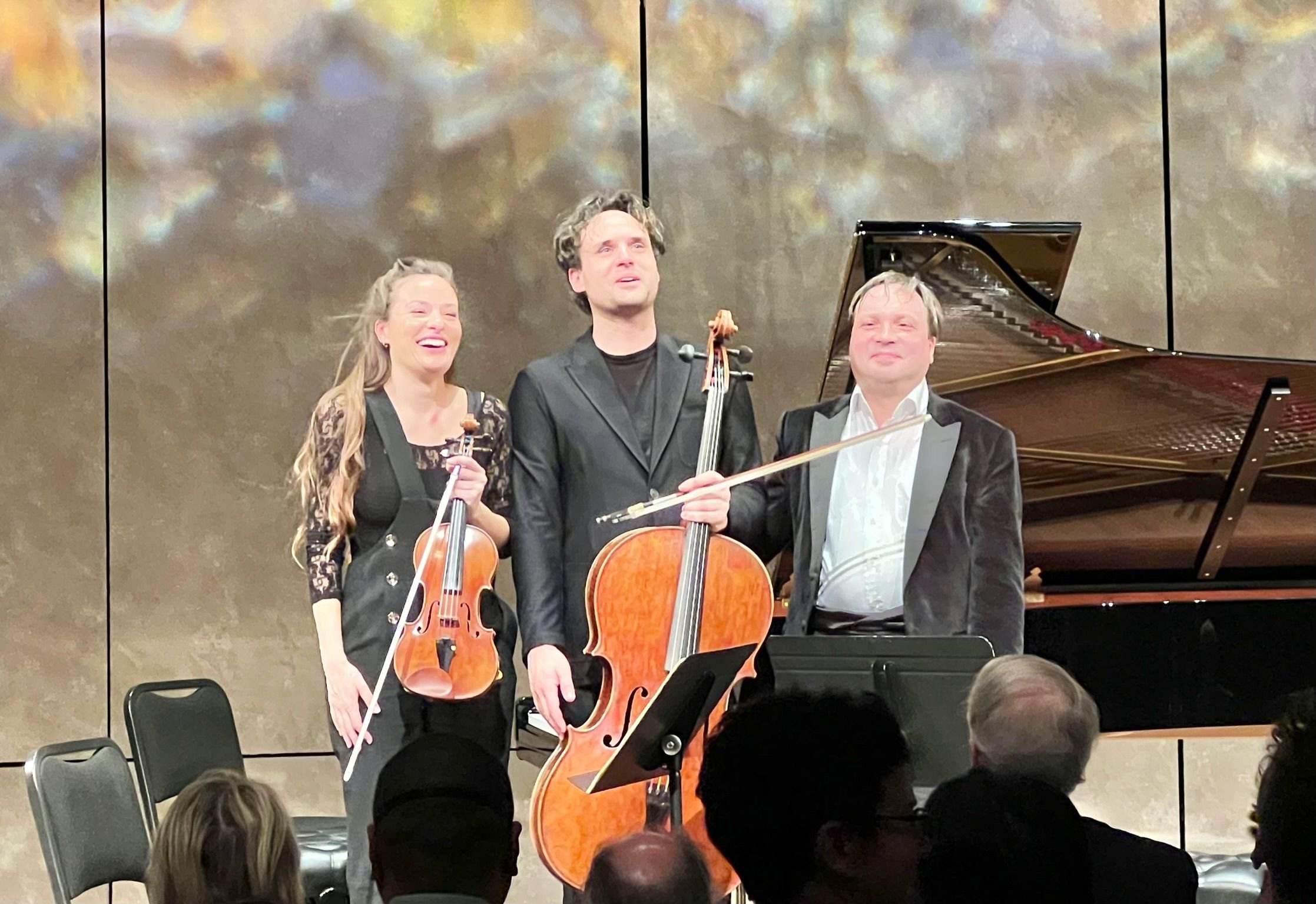Praise for the Benedetti-Eischenbroich-Grynyuk Trio performance at San Fransisco’s Herbst Theatre
Nicola Benedetti, Leonard Elschenbroich and Alexei Grynyuk taking a bow after performing at Herbst Theater in San Fransisco
Benedetti/Eischenbroich/Grynyuk Trio at San Francisco’s Herbst Theatre
By James Roy MacBean
The Berkeley Daily
March 27, 2023
Scottish-born violinist of Italian heritage Nicola Benedetti is in great demand internationally as a violin soloist with the world’s leading symphony orchestras. In addition, over the last decade she has been performing chamber music with German cellist Leonard Eischenbroich and British-Ukrainian pianist Alexei Grynyuk in a trio format. On Wednesday, March 22, this trio made its local debut at Herbst Theatre sponsored by San Francisco Performances. On the program were two Piano Trios: the E-flat Major Trio, D. 929, by Franz Schubert, and Piotr Tchaikovsky’s Piano Trio in A minor, Op. 50.
These are two heavyweights in the trio repertoire. The last time I heard the Schubert trio was in early March, 2020, just before the Covid pandemic put a stop to public concerts for almost 18 months. That 2020 performance was led by local pianist Audrey Vardanega, and it also featured local cellist Tanya Tomkins and local violinist Nigel Armstrong. I lauded that performance of this Schubert Piano Trio for its refinement, elegance, and attention to emotional range while emphasising Schubert’s wealth of gorgeous melodic material. Now, by contrast, the Benedetti/Eischenbroich/Grynyulk Trio wins my approval for its sinewy character, its turbulence, its monumentality and passionate intensity as well as its faithful commitment to Schubert’s gorgeous melodies. Let me state it clearly: both interpretations seem viable. Schubert’s music can be embraced in many different ways, especially if the composer’s extraordinary gift for melodies is paramount. Schubert once said that “As soon as I write down a melody, many new melodies invade my mind.”
Lasting three-quarters of an hour, Schubert’s E-flat Major Trio is of gigantic proportions for a piano trio. Written in the last year of his tragically short life, this trio offers some of Schubert’s last and greatest music. The opening theme is introduced in just six measures, but it opens the way for amazing counter themes that ensue. As the program notes indicate, “It is as if that basic shape is so pregnant and Schubert’s melodic gift so fertile that themes are being born in front of us.” The second movement, marked Andante con moto, begins with the piano offering an unsteady rhythm that throws us off our usual rhythmic base. The piano and cello offer what seems to be a funeral march. Over this irregular rhythm the cello offers a soaring main melody. Midway through this movement there is a dramatic episode full of Sturm und Drang. Finally, it rises to a huge climax before ending quietly on the opening theme.
The third movement is a Scherzo, brief and bouncy, a mix between a minuet and a rondo. The concluding final movement, marked Allegro moderato, is quite long, lasting nearly twenty minutes even after the cuts Schubert made before publishing it. Twice in this movement Schubert repeats a theme, often called “the Swedish theme,” from the slow movement. This rhythmically varied reappearance is one of the most striking elements of this work, here beautifully performed by the Benedetti/Eischenbroich/Grynyuk Trio.
Closing this program was Piotr Tchaikovsky’s Piano Trio in A minor, Op.50. Conceived in 1882 as a tribute to the memory of Nikolai Rubenstein, the recently deceased brother of the pianist Anton Rubenstein. This piano trio is the only chamber music work in which Tchaikovsky consented to combine a piano with strings. Consisting of two massive movements that last 50 minutes, this work has confounded critics, who debate endlessly over whether the opening movement’s form is that of a sonata or a rondo. It opens with a somber melody from the cello, and there follows a contrasting descending theme from the piano.
The second movement offers a huge set of 11 variations on a simple peasant melody much loved by Nikolai Rubenstein. These variations are endlessly fruitful, though the composer was dumbfounded and distraught when critics tried to associate each variation with an episode in Nikolai Rubenstein’s life. The conclusion, marked Lugubre (Lugubrious), brings a repeat of the cello’s theme from the opening movement, now played “weepingly,” as the work gradually fades away into silence.
After passionately involving themselves in performing these two demanding Piano Trios, the Benedetti/Eischenbroich/Grynyuk Trio gratefully acknowledged the standing applause of the audience. However, after concentrating their efforts on these two weighty piano trios, they wisely eschewed performing any encores, which would have been superfluous.
Read the full review here.

